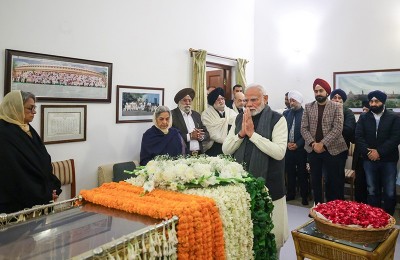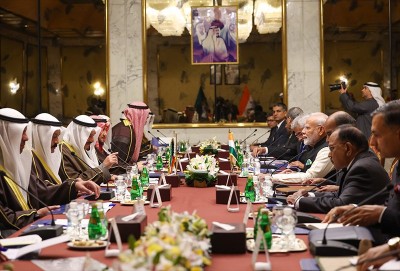
Meghalaya: Vulnerabilities Persist
On October 24, 2015, the dead bodies of Assistant Central Intelligence Officer (ACIO) of the Intelligence Bureau (IB), Bikash Kumar Singh (32) and cloth merchant Kamal Saha, were recovered in a decomposed state, from a village in Meghalaya's South Garo Hills District. They had been abducted by A'chik Songna An'pachakgipa Kotok (ASAK) militants at gunpoint between Ampangre and Panda Reserve Forest onSeptember 23, while they were travelling in a public vehicle towards Baghmara, the District headquarters of South Garo Hills, from Rongara.
On October 19, Fakrul Islam (32), a resident of Krishnai Badwan in the neighbouring Assam State, was killed by suspected militants in Bajengdoba village in the North Garo Hills District of Meghalaya. Islam's body was recovered in the Bajengdoba Police Station jurisdiction in East Garo Hills District.
On October 7, two suspected members of a 'kidnappers' gang' were killed by Garo National Liberation Army (GNLA) militants in the Chi A'ding area and their bodies were dumped on the new highway road connecting Jengjal with Williamnagar in East Garo Hills District.
On October 1, suspected GNLA militants killed two Policemen near a hanging bridge at Kusumkolgre in Williamnagar of East Garo Hills District. The two Constables, Helpingstone Nongkseh, and Kundan Dalu, both 24, in civilian clothes, were travelling from the Bolkingre camp to Williamnagar on a motorcycle around 3 pm when the militants opened fire, killing them on the spot.
According to partial data compiled by the South Asia Terrorism Portal (SATP), Meghalaya has recorded at least 53 militancy-linked fatalities, including 16 civilians, seven Security Forces (SFs) personnel and 30 militants, as of November 1, 2015, against 69 such fatalities, including 20 civilians, four SF personnel and 45 militants, during the corresponding period of 2014. The fatalities for the whole of 2014 stood at 76, including 23 civilians, six SF personnel and 47 militants. Though two months remain in 2015, SF fatalities this year have already crossed last year's total. Insurgency related data for 1992-2015 indicates an interesting trend: between 2003 and 2012, SF fatalities exceeded five only once, in 2011 [at 10], while fatalities over the past three years [2013-15] have consistently remained above five.
According to the State Police, during Operation Hill Storm 2, the anti-insurgency operation conducted between April 2 and June 6, 2015, at least 17 militants were killed, including seven cadres of GNLA, four cadres of A'chik Matgrik Elite Force (AMEF), two cadres of ASAK, and one cadre each of the Independent faction of United Liberation Front of Asom (ULFA-I) and Liberation of Achik Elite Force (LAEF). The group affiliation of the remaining two was not known.
In Operation Hill Storm 1, [conducted between July 7, 2014, and December 31, 2014, SFs had killed 16 militants [seven GNLA, five ASAK, two United A'chik Liberation Army (UALA), and one each of ULFA-I and LAEF]. Another 24 militants were injured during the operation. The official statement had also disclosed that six Policemen were killed and another 10 SF personnel were injured during this period.
The successful beating back of the insurgents by the SFs in Operations Hill Storm 1and 2 did raise hopes of larger peace in the State. However, militants appear to have retained a measure of disruptive dominance in parts of the State. In a statement issued to the media on August 9, 2015, GNLA declared that its team of 'Eagle Hunters' [a seven-member 'special operation team'] was specifically formed to carry out attacks on Police personnel anytime anywhere: "Our Eagle Hunters team will shoot Police personnel dead on the spot no matter how many Police personnel are there at the time of the incident." Evidently, the militants are attempting to salvage what they can of their abduction and extortion business in the face of the SFs operations in their erstwhile areas of dominance.
Abduction-for ransom has long been rampant, especially in the Garo Hills Region. These incidents are the handiwork of not only the GNLA, but all other militant outfits operating in Meghalaya, including ASAK and AMEF. According to SATP data, in the current year, until November 1, 2015, at least 40 incidents of abduction, in which 64 persons were abducted, have been reported, as compared to 39 such incidents resulting in 51 abductions during the corresponding period of 2014. Reported incidents are likely to be a fraction of the actual incidence of such crimes, as families of victims often settle with the abductors without reporting to the Police.
In the latest of a series of such incidents, on October 27, 2015, GNLA militants abducted the Block Development Officer (BDO) of Chokpot region in South Garo Hills District, near Deku Deganggre. Jude Rangku T. Sangma, a 2010 Meghalaya Civil Service batch officer, had left the Chokpot Block Office around 4:30 pm, enroute to Tura Town, and had stopped over at a funeral of a relative in Deku Deganggre village, 25 kilometres from Chokpot town. Police sources revealed that GNLA 'commander' Hedeo Ch Momin alias Karak was the 'mastermind' behind this abduction. Sangma is still to be traced and his abductors have threatened to execute him if counter-insurgency operations in the Garo Hills are not stopped.
According to the Police, on October 7, 2015, during an operation to rescue Waseem Ahmed (25), an engineer with the BSC C&C Construction Company who was abducted on September 29, 2015, SF personnel came across a new militant outfit, the United Garo Security Force (UGSF). Meghalaya Police launched a coordinated rescue operation to mount pressure on the UGSF militants to release Ahmed, which also led to the arrest of six UGSF militants. Police however suspect that Ahmed's kidnappers belonged to the A'chik National Liberation Army (ANLA) , operating under the cover of UGSF.
The 'business' has also provoked jealous turf wars. GNLA, the most lethal group in the State, thus executed two suspected members of a 'kidnappers' gang' on October 7, 2015, for their suspected involvement in a string of cases in the Chi A'ding area, dumping their bodies on the road connecting Jengjal with Williamnagar in East Garo Hills District. Earlier, on February 3, 2015, suspected GNLA militants attacked Bolmoram Agalgre village after learning about the presence of cadres of its rival breakaway faction ASAK. A teenage girl, Manchi Ch Marak, and an unidentified ASAK militant were killed in the gun battle that followed, and one ASAK cadre was injured.
According to the latest Union Ministry of Home Affairs (UMHA) figures, however, the entire Northeast region has seen a significant decline in incidents of abduction in 2015. The worst-affected State, Assam, registered a drop of nearly 70 per cent, even as the recently banned Khaplang faction of National Socialist Council of Nagaland (NSCN-K) resorted to the maximum number of abductions for any outfit in 2015. 182 kidnappings have been reported till September 15 in the current year from the seven Northeastern States, compared to 250 in the same period last year, and 369 in all in 2014. Assam saw a drop from 125 abductions in 2013 and 94 in 2014, to just 24 this year, thus far. Kidnappings in Meghalaya, according to UMHA data, were down from 110 last year to 45, so far, this year. Arunachal registered 24 such cases this year, down from 49 in 2014.
In a significant development, the 'political and organising secretary' of Hynniewtrep National Liberation Council (HNLC), identified as Fredrick Kharmawphlang, surrendered before Sunil Kumar Jain, the Chief intelligence officer of Meghalaya Police on July 31, 2015. Kharmawphlang was reportedly disillusioned with the HNLC leadership in Bangladesh because they engaged in 'immoral activities' at the cost of the Khasi people on whose behalf they claimed to be fighting. According to Jain, "Kharmawphlang realized a bleak future for HNLC because of its leadership and he fled from his hideout in Putisara village in Bangladesh and surrendered himself to the law in the presence of his parents and some members of the Khasi Student's Union." However, HNLC subsequently stated that it was his (Kharmawphlang's) personal decision to return to the mainstream and "we do not have any qualms or complaints." HNLC also claimed that it had joined hands with other "stronger organisations" of the Northeast, and would soon "co-ordinate" to prove that they "still exist."
Indeed, if Paresh Baruah, 'commander-in-chief' of ULFA-I is to be believed, two Meghalaya-based outfits - GNLA and HNLC - had expressed their desire to join the United National Liberation Front of Western South East Asia (UNLFWSEA), a common platform of militants in India's Northeast.
Meanwhile, concerned over the delay in the implementation of the 'Agreed Text for Settlement', which was signed between the A'chik National Volunteer Council (ANVC), breakaway faction of A'chik National Volunteer Council (ANVC-B), the Centre and the Meghalaya Government in September 24, 2014. Bernard Rimpu N. Marak, former leader of the ANVC-B, observed, on October 25, 2015, "The delay of which is obstructing the good days from dawning in Garo Hills. Good governance is the core vision of the agreed text which has to be materialized against all odds and obstructions. The state should implement the agreement instead of dilly-dallying the entire rehabilitation process (sic)" Bernard argued that the "agreed text" was a solution to many issues related to the people of Garo Hills. Earlier, in an initiative to overcome the Government's failure to implement the Agreed Text for Settlement, Bernard declared, on September 6, 2015, that his group would contest the Garo Hills Autonomous District Council (GHADC) polls on October 12, 2015, to fulfill their demands. Bernard had contested as an independent candidate for Tura constituency while former ANVC-B's 'commander-in-chief' Bidith Sangma contested for Siju constituency. However, both Bernard and Sangma lost their respective seats.
Meanwhile, in an effort to push active militants to return to the mainstream, Union Minister of State for Home Affairs Kiren Rijiju, on August 21, 2015, announced that Government of India (GoI) had decided to hold talks with militant groups only after they surrender and deposit their arms and ammunition to concerned authorities: "We have made an appeal to those (militant groups) who wanted to come to the mainstream, that the first and foremost is to lay down arms and abjure violence because violence and talk cannot go parallel... We will not talk to anybody who indulges in any kind of violence."
While there has been a sustained decline in insurgent violence in India's Northeast over the years, the persistence of violence and the proliferation of militant factions in Meghalaya threaten the possibilities of an enduring peace in the State.
Support Our Journalism
We cannot do without you.. your contribution supports unbiased journalism
IBNS is not driven by any ism- not wokeism, not racism, not skewed secularism, not hyper right-wing or left liberal ideals, nor by any hardline religious beliefs or hyper nationalism. We want to serve you good old objective news, as they are. We do not judge or preach. We let people decide for themselves. We only try to present factual and well-sourced news.







